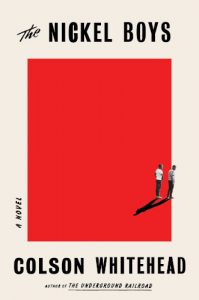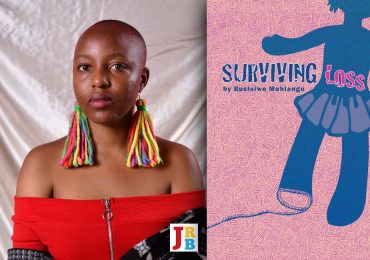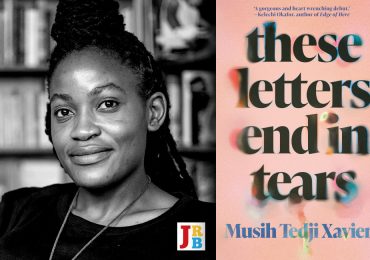The Nickel Boys is a powerfully controlled novel in which the main character learns that there are no rules by which he can survive America’s intemperate violence, writes Wamuwi Mbao.

The Nickel Boys
Colson Whitehead
Little, Brown, 2019
America’s vast nostalgia industry tirelessly regenerates the country’s past as a glossy Polaroid. It does so at its convenience, taking stills from the Americana registry and blowing them up as artefacts in a national diorama about The Good Life. When Gil Scott-Heron opined that America had fallen prey to selective amnesia—‘remembering what we want to remember and forgetting what we choose to forget’—he was diagnosing an enduring national malaise. America has two kinds of past—there is the pastels-and-Cadillac past it likes to return to, through the gauzy filter of Lana Del Rey songs and on-demand television, which is the past looked at with self-exonerating irony. Then there is the past whose ugliness crusts and corrodes and contaminates the present, and won’t be wished away by collective forgetting or assurances of current sincerity.
There is clearly a need for an uncomfortable reckoning in a country that elects a sabre-rattling white supremacist as president. There is a need for an uncomfortable reckoning in a country that shoots down Black people in their streets. There is a need for an uncomfortable reckoning because injustice towards Black people has been allowed to inhabit the American social fabric with impunity. James Baldwin saw it. Audre Lorde saw it. Toni Morrison certainly saw it.
Elwood Curtis, the main character in Colson Whitehead’s new novel The Nickel Boys, knows this too. When the novel begins, we find him as a middle-aged man living in New York City, where he is a successful business owner. Elwood is about to open another office and generally doing well at life. Yet he is in the grip of this same malaise. He watches the news one night, as the story emerges of bodies found in the grounds of an old reformatory school. Elwood, we learn, also spent a few years at the Nickel Academy, which is a fictional stand-in for one of a number of real-world analogues, including a reform school in Florida where more than fifty graves have been unearthed.
Elwood prefers to keep the world at arm’s length, unlike the old boys who form a support group to work through their shared trauma:
The annual reunion, now in its fifth year, was strange and necessary. The boys were old men now, with wives and ex-wives and children they did or didn’t talk to, with wary grandchildren who were brought around sometimes and those whom they were prevented from seeing. They had managed to scrape up a life after leaving Nickel or had never fit in at all with normal people. The last smokers of cigarette brands you never see, late to the self-help regimens, always on the verge of disappearing. Dead in prison, or decomposing in rooms they rented by the week, frozen to death in the woods after drinking turpentine.
Elwood restlessly stalks the support group websites and news articles on the Nickel boys, but he keeps to himself and wants no truck with the past:
What was the point? Grown men. What, you take turns handing each other Kleenex? One of the others posted a story about the night he parked outside Spencer’s house, watching the windows for hours, the silhouette figures inside, until he talked himself out of revenge. He’d made his own leather strap to use on the superintendent. Elwood didn’t get it. Go all that way, might as well follow through.
Elwood is reluctantly galvanised to act when the school’s grim secrets are discovered. Seeing Nickel on the news, he realises that the traumatic past cannot be eluded: ‘It wasn’t far off at all. Never will be.’
The story that unfolds over the three parts of this grief-compacted novel descends to the Civil Rights-era Deep South, a territory that has taken on mytho-nightmarish status in the Black American cultural imaginary. We meet Elwood as a bright young boy just starting to become aware of the cruelties of Black life. With his parents having lit out for California (their freedom does not include him), his grandmother Harriet raises him. The old woman tries to instil a sense of rectitude in her charge. The young Elwood, for his part, watches his grandmother work at the town hotel, and notices with the earnest attention of a child that no Black patrons ever frequent the attached restaurant, even though desegregation has been made law already.
The distance between the law and reality becomes ever more apparent to Elwood as he grows. In one poignant scene, Elwood is drawn into a dishwashing contest with the hotel staff (who are abusing the boy’s good faith). He triumphs, and collects as his prize a box of encyclopaedias, left behind by a white patron. When he drags the box home, we are told that ‘to see him from across the street—the serious young lad heaving his freight of the world’s knowledge—was to witness a scene that might have been illustrated by Norman Rockwell, if Elwood had had white skin.’
Elwood listens over and over to a record of Dr Martin Luther King Jr’s speeches, and from these he bears away the lesson that stoic adherence to The Right Thing in the face of injustice will eventually bring about the triumph of justice. One of these speeches in particular sticks with Elwood. In it, Dr King recounts his daughter’s excitement at the arrival in Atlanta of an amusement park:
Dr King had to tell her in his low, sad rumble about the segregation system that kept colored boys and girls on the other side of the fence. Explain the misguided thinking of some whites—not all whites, but enough whites—that gave it force and meaning.
Elwood is aware, then, that white America is dangerous, but his mistake is to believe that the world is structured by rules that, if diligently applied, will see him through. His role model’s impossible patience in the face of abject violence presents Elwood with a fatal example to follow. He excels at his schoolwork, and seems poised to leave the limits of his world behind, when a young teacher arranges for him to attend college classes. But a painfully arbitrary encounter finds Elwood on the wrong side of the law, and he is remanded to the care of the Nickel Academy until such time as he is deemed fit for return to society.
The reformatory is an unwalled institution where the lack of physical boundaries signals to the unseen barbed threat that keeps the inmates contained. Nickel houses ‘wards of the state, orphans, runaways who’d lit out to get away from mothers who entertained men for money or to escape rummy fathers who came into their rooms in the middle of the night.’ The boys pass unremembered and unmourned into oblivion. Whitehead pulls back the curtains by flashing forward to tell us that one character leaves Nickel only to die in a knife fight on a juke-joint floor. The boys are unlikeable, grotesque even, but bound by the shared fate of an inscrutably cruel world governed by abusive adults.
It takes Elwood a while to learn that there are no rules by which he can survive the intemperate violence of the reformatory. After he intervenes in a fight, he and the combatants are rounded up and flogged in the White House, a creepy converted laundry room whose name doesn’t carry enough irony to account for the horrors that happen there. Hospitalised after the savage beating he receives, Elwood befriends Turner, a streetwise Stepin Fetchit-type who knows the lay of the land. Turner is a deceptive character, never quite meeting our gaze, but steadily becoming more and more important until he’s sharing the story with Elwood. We surmise that there may be something compassionate in Turner’s character—he looks out for Elwood and eventually helps him escape Nickel—but he seems greyed-out when we hover over him.
The friendship between Elwood and Turner occupies most of the book, encouraging us to think about the tenuous solidarities that can flourish under such harsh conditions. Elwood passes his days at Nickel in the quicksand purgatory of his inability to effect his freedom. A character in Whitehead’s 2009 novel Sag Harbor voices this dilemma in a way that echoes throughout The Nickel Boys: ‘Move. Don’t move. Act. Don’t act. The results were the same. This was my labyrinth.’ Elwood’s confusion before the labyrinth is focused more clearly: Elwood, how do you negotiate a world that is indifferent to your ethics? What are morals when they are ground beneath authority’s boot?
It is an ambitious thing indeed to take on a story that is still being exhumed. Whitehead has always been concerned with troubling American modernity. His work, from the salty Apex Hides the Hurt to the emotionally scouring The Underground Railroad, is caught in a push-pull struggle to unmask the ugly face of American life. The novels bulge with ideas and they are energised by the bizarreness of their geographical setting. And while this has occasionally ballooned into a ricocheting prolixity, The Nickel Boys is Whitehead at his most powerfully controlled. He tells a messy story without allowing the novel to be controlled by that messiness. The prose is elastic, winding back on itself until the suspense is stretched taut, and releasing a beat before you expect it to, with a twist that isn’t at all what you expect.
If there is a criticism to be voiced, it might be that the novel strains noticeably under the burden of the news on which it is based. Its primary concern is the uncovering of the past, and so it leans creakily in the present-day scenes. The older present-day Elwood moves restlessly through his city as though being pursued, but his characterisation sometimes seems a little thin-backed. The portrayal is, as we learn, a misleading one. It’s part of the way Whitehead rations out detail, only to suddenly open up in a bloom of revelation that is shocking and unsettling.
The latter half of this decade has seen the rise of a kind of cultural text that refuses the tyranny of American beauty, by which I mean the country’s relentless need to find something redemptive in its ugliness. For every one of the myths that structure Americana, there is the foul violence that briefly shakes the country from its stupor. The Nickel Boys, Jesmyn Ward’s Sing, Unburied, Sing, Raoul Peck’s I Am Not Your Negro, Ta-Nehisi Coates’ Between the World and Me, to say nothing of Jordan Peele’s the-nightmare-is-how-real-it-is Get Out: these texts are a cold B-side to the American Dream.
The Nickel Boys is a disquieting novel for disquieting times. Staying on the B-side, shows like Ava DuVernay’s When They See Us are electrifying in the way they remind us that the rediscovery of Black people’s humanity will not be accomplished through glib celebratory auterism—films like Peter Farrelly’s Green Book or the inane post-racial carpetbagging of Kanye West. Whitehead’s novel takes historical horror as its starting point, but uses the void of suppressed truth as a space for telling a story about the dark secret that haunts the country’s attic.
- Wamuwi Mbao is an essayist, cultural critic and academic at Stellenbosch University. Follow him on Twitter.





